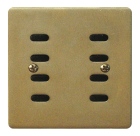Lighting control that is fit for purpose

Many lighting-control systems are not designed for the particular purpose or are not kept up to date with changing demands. John Aston of the Society of Light & Lighting looks into the problem.
Automatic lighting controls are often used as a means to demonstrate that a commercial building has been designed to comply with the requirements of Part L of the Building Regulations, which have included lighting energy conservation since 1992.
As a result there are a large number of recently constructed and refurbished buildings that contain lighting-control systems. But how many of these systems are currently operating correctly and delivering electricity savings? One look across the London skyline late at night suggests that many are not.
Lighting uses close to 20% of the electricity generated in the UK, and much of this use falls within the non-domestic built environment. Demonstration projects in the 1980s showed that properly applied lighting controls were capable of reducing lighting electricity use by as much as 60%. However, these projects were almost all retrofit solutions specifically designed to suit the use and occupation of the buildings. They all had high levels of local user controls, permitting staff to make their own decisions about when, and where, the lights were ON. Generally these controls worked on the principle that occupants had to turn ON the lighting as required, and the automatic system turned the lighting OFF when not needed. The results were convincing and led to widespread acceptance and specification of lighting controls as original equipment in new building designs.
Lighting controls supplied as original equipment in a construction project are subject to a very different design, installation and commissioning process when compared to a tailored retrofit project.
 |
| Is this really helpful? A light switch must do what the user expects; turn it ON or OFF instantly! (Photo: John Aston) |
For a start there may not be a tenant on board, so the lighting controls cannot be matched to the intended occupation. When a property is let, the fit-out contract may not involve the direct input of the tenant, and lighting controls are set to operate without sufficient thought being given to the actual use of the space.
The chances of getting lighting controls properly set up are then further diminished because the maintenance contract is given to a third-party provider.
In short the complications of our property contracts often reduce the likelihood of a lighting-control system being correctly fitted out and commissioned to suit the actual user. And all of this is likely to be aggravated by budget decisions that minimise the immediate contract costs without any thought about the running and whole-life costs involved.
So what is happening in this construction process that is stopping us from using the lighting controls effectively?
Often it is not just the disconnect between original cost and running cost, but also a lack of knowledge about how a lighting-control system should be configured that leads to poor performance. Perceived savings in investment costs can lead to under-specified systems being installed, limiting the opportunities for lighting electricity cost savings in the future.
For example, a specification requiring the lighting to be dimmed might be relaxed and fixed-output luminaires permitted instead. Such a change can dramatically reduce the ability of a control system to deliver savings. Decisions like this are born out of a lack of insight into the capabilities of lighting-control systems. Other factors that can reduce savings include insufficient local controls and incorrectly set operating parameters. Indeed many systems will default to being continuously ON if they are not kept up to date and programmed correctly.
All parties in the process need to understand the key factors contributing to the successful application of lighting controls.
 |
| What we could be aiming for with lighting control — a gradual turning off of lights at the end of the working day. |
The original design must provide an infrastructure that allows the most efficient luminaires and appropriate local user controls to be added as the building becomes occupied. When the building is let the tenant fit-out must ensure that controls are as convenient and effective as possible; this means not only providing sufficient local controls but also making sure that incoming staff fully understand their operation. Too often the function of local switches is not obvious, or they are poorly labelled. The tenant must also be closely involved in setting the system to work and the commissioning process.
By gaining a reasonable understanding of how control systems work it is then possible to look at the daily operational requirements of a business and set-up the lighting controls accordingly.
A desire to avoid any distraction or disturbance frequently leads to operating times being set well beyond normal hours of occupation. Tailoring the lighting control regimes to suit local staff needs — and informing them about what is happening — allows them to be much more closely linked to the actual hours of use.
Recognising that the out-of-hours use of the space for maintenance, cleaning or security purposes requires lower levels of lighting will also generate electricity savings.
It is often said that ‘a little knowledge can be a dangerous thing’, but it is lack of knowledge that leads to lighting controls being badly set up and left in a virtual state of redundancy. Any reputable lighting-controls supplier will be more than happy to offer operational advice at all stages of a construction project — including the provision of training and maintenance support.
John Aston is vice-president of the Society of Light & Lighting.







